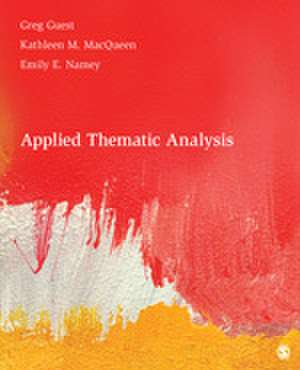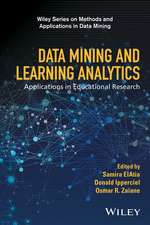Applied Thematic Analysis
Autor Greg Guest, Kathleen M. MacQueen, Emily E. Nameyen Limba Engleză Electronic book text – 13 noi 2018
Preț: 386.27 lei
Nou
Puncte Express: 579
Preț estimativ în valută:
65.24€ • 70.89$ • 54.84£
65.24€ • 70.89$ • 54.84£
Indisponibil temporar
Doresc să fiu notificat când acest titlu va fi disponibil:
Se trimite...
Preluare comenzi: 021 569.72.76
Specificații
ISBN-13: 9781544367217
ISBN-10: 154436721X
Pagini: 320
Ediția:1
Editura: SAGE Publications
Colecția Sage Publications, Inc
Locul publicării:Thousand Oaks, United States
ISBN-10: 154436721X
Pagini: 320
Ediția:1
Editura: SAGE Publications
Colecția Sage Publications, Inc
Locul publicării:Thousand Oaks, United States
Recenzii
“There
are
few
qualitative
texts
that
really
present
a
step-by-step
process
of
how
to
analyze
qualitative
data
in
a
systematic
and
rigorous
way.
It
is
very
well
written,
students
will
find
this
text
helpful.
The
examples
are
great.”
“I like that it is practice focused. The real world examples are key and the real world problems make the text more useful. The exercises are nice to pick from for in-class activities or small projects.”
I really think that this is the book that was very much needed. Thematic analysis in my experience is one of the most popular techniques that students use in their dissertations, but there has been little written about methodological foundations and the actual process and procedures of this kind of analysis. I think this book fills this gap very well and provides the description of actual analytical techniques to make the process more structured and rigorous. The book also incorporates examples from NVivo which is a very popular software with many institutions at the moment. The second section is about quantifying qualitative findings – and integrating quantitative and qualitative data. I find the description interesting and there are a couple of very useful tables and classifications of how to do it which no doubt will be useful for students. The section on writing up findings is really useful and I think can be used as a teaching material even if one is not using thematic analysis. Overall the book is very good and I would definitely recommend it to students on Dissertation Writing modules and/or PG Research Methods.
“I like that it is practice focused. The real world examples are key and the real world problems make the text more useful. The exercises are nice to pick from for in-class activities or small projects.”
I really think that this is the book that was very much needed. Thematic analysis in my experience is one of the most popular techniques that students use in their dissertations, but there has been little written about methodological foundations and the actual process and procedures of this kind of analysis. I think this book fills this gap very well and provides the description of actual analytical techniques to make the process more structured and rigorous. The book also incorporates examples from NVivo which is a very popular software with many institutions at the moment. The second section is about quantifying qualitative findings – and integrating quantitative and qualitative data. I find the description interesting and there are a couple of very useful tables and classifications of how to do it which no doubt will be useful for students. The section on writing up findings is really useful and I think can be used as a teaching material even if one is not using thematic analysis. Overall the book is very good and I would definitely recommend it to students on Dissertation Writing modules and/or PG Research Methods.
Cuprins
Chapter
1.
Introduction
to
Applied
Thematic
Analysis
Chapter 2. Planning and Preparing the Analysis
Chapter 3. Themes and Codes
Chapter 4. Validity and Reliability (Credibility and Dependability) in Qualitative Research and Data Analysis
Chapter 5. Supplemental Analytic Techniques
Chapter 6. Data Reduction Techniques
Chapter 7. Comparing Thematic Data
Chapter 8. Integrating Qualitative and Quantitative Data
Chapter 9. Choosing Qualitative Data Analysis Software
Chapter 10. Writing Up Thematic Analyses
Chapter 2. Planning and Preparing the Analysis
Chapter 3. Themes and Codes
Chapter 4. Validity and Reliability (Credibility and Dependability) in Qualitative Research and Data Analysis
Chapter 5. Supplemental Analytic Techniques
Chapter 6. Data Reduction Techniques
Chapter 7. Comparing Thematic Data
Chapter 8. Integrating Qualitative and Quantitative Data
Chapter 9. Choosing Qualitative Data Analysis Software
Chapter 10. Writing Up Thematic Analyses
Descriere
A
clear
introduction
to
analysing
the
data
obtained
from
focus
groups
and
interviews.







